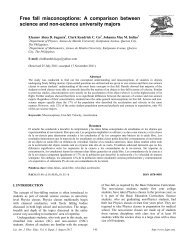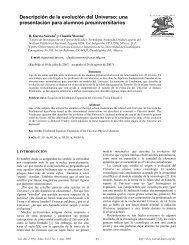Malus's law of light polarization using a Computer-Based Laboratory
Malus's law of light polarization using a Computer-Based Laboratory
Malus's law of light polarization using a Computer-Based Laboratory
You also want an ePaper? Increase the reach of your titles
YUMPU automatically turns print PDFs into web optimized ePapers that Google loves.
Malus’s <strong>law</strong> <strong>of</strong> <strong>light</strong> <strong>polarization</strong> <strong>using</strong><br />
a <strong>Computer</strong>-<strong>Based</strong> <strong>Laboratory</strong><br />
D. Amrani and P. Paradis<br />
University <strong>of</strong> Quebec, École de Technologie Supérieure,<br />
Service des Enseignements Généraux,<br />
1100, rue Notre-Dame Ouest Montreal (QC) H3C 1K3, Canada.<br />
Tel: (514) 396-8583, fax: (514)396-8513<br />
E-mail: damrani@seg.etsmtl.ca<br />
(Received 12 March 2009; accepted 5 May 2009)<br />
Abstract<br />
An experimental arrangement based on computer-controlled data acquisition system was used to measure the <strong>light</strong><br />
intensity transmitted through two polarizers and the angle, θ, <strong>of</strong> the axes <strong>of</strong> the polarizers. The setup was proposed to<br />
physics undergraduate students to do real hands-on experiment where real-time display <strong>of</strong> the experimental data<br />
facilitates the analysis and interpretation <strong>of</strong> the results. The excellent quantitative and qualitative results are reported<br />
and compared with the exact theory <strong>of</strong> Malus’s <strong>law</strong>. The slope <strong>of</strong> the plotted data <strong>of</strong> <strong>light</strong> intensity versus cos 2 θ has an<br />
uncertainty within 0.8% <strong>of</strong> unity.<br />
Keywords: Light <strong>polarization</strong>, Malus’s <strong>law</strong>, <strong>Computer</strong>-based laboratory.<br />
Resumen<br />
Se utilizó un arreglo experimental basado en un sistema de adquisición de datos controlados por computadora para<br />
medir la intensidad de la luz transmitida a través de dos polarizadores y el ángulo, θ, de los ejes de los polarizadores.<br />
La instalación se propuso a estudiantes de física para hacer prácticas reales en donde se muestra la adquisición de datos<br />
experimentales en tiempo real que facilitan el análisis y la interpretación de resultados. Los excelentes resultados<br />
cuantitativos y cualitativos son reportados y se comparan con la teoría exacta de la ley de Malus. La pendiente de la<br />
traza de datos de la intensidad de la luz contra el cos 2 θ posee una incertidumbre en el 0,8% de la unidad.<br />
Palabras clave: Polarización de la luz, ley de Malus, Laboratorio basado en computadora.<br />
PACS: 01.40.gb, 01.50.My, 01.50.Lc. ISSN 1870-9095<br />
I. INTRODUCTION<br />
Sensors attached to a computer are being used in most<br />
experimental physics and chemistry research laboratories.<br />
These sensors create a very powerful system for the<br />
collection, analysis and display <strong>of</strong> experimental data. In<br />
this paper, hands-on experiment combined with a<br />
computer-based acquisition system was used to investigate<br />
the Malus' <strong>law</strong> <strong>of</strong> <strong>polarization</strong>.<br />
In this activity, we worked with different experimental<br />
arrangement relative to the one described in literature [1].<br />
A diode laser instead <strong>of</strong> a basic optic <strong>light</strong> source and a<br />
collimating lens divergent <strong>of</strong> 10 cm focal length [2] were<br />
introduced to the experimental setup in order to obtain<br />
qualitative and quantitative measurements <strong>of</strong> Malus’ <strong>law</strong><br />
<strong>of</strong> <strong>polarization</strong> <strong>of</strong> <strong>light</strong>.<br />
A <strong>light</strong> from diode laser source was passed through two<br />
polarizers. As the second polarizer, analyzer, is rotated by<br />
hand, the relative <strong>light</strong> intensity is recorded as a function<br />
<strong>of</strong> the angle between the axes <strong>of</strong> <strong>polarization</strong> <strong>of</strong> the two<br />
polarizers. The angle was measured <strong>using</strong> rotary motion<br />
sensor coupled to the polarizer with a drive belt. The plots<br />
<strong>of</strong> <strong>light</strong> intensity versus angle, the intensity versus cosine<br />
angle and the intensity as a function <strong>of</strong> cosine 2 angle were<br />
fitted. The experimentally result was matching the<br />
predicted relationship between the <strong>polarization</strong> direction <strong>of</strong><br />
the <strong>light</strong> and the intensity <strong>of</strong> that <strong>light</strong> transmitted through<br />
a second polarizer. The plotted data <strong>of</strong> the intensity versus<br />
the cos 2 θ was representing a linear regression having a<br />
slope within an uncertainty <strong>of</strong> 0.8 % <strong>of</strong> unity.<br />
We believe that the experimental setup, employing<br />
<strong>polarization</strong> analyzer system coupled with a computer<br />
<strong>using</strong> Datastudio s<strong>of</strong>tware and Science workshop 750<br />
interface supplied by PASCO [3], could be very useful and<br />
practical to physics students undertaking this kind <strong>of</strong><br />
laboratory experiment to get satisfactory results.<br />
Lat. Am. J. Phys. Educ. Vol. 3, No. 2, May 2009 229 http://www.journal.lapen.org.mx
D. Amrani and P. Paradis<br />
II. THEORY<br />
When unpolarized <strong>light</strong> is incident on an ideal polarizer,<br />
the intensity <strong>of</strong> the transmitted <strong>light</strong> is one-half <strong>of</strong> the<br />
incident <strong>light</strong>. A diode laser was used as the <strong>light</strong> source<br />
for this experiment. This <strong>light</strong> is already polarized, so most<br />
<strong>of</strong> the <strong>light</strong> will pass through a polarizer oriented with its<br />
axis <strong>of</strong> <strong>polarization</strong> parallel to that <strong>of</strong> the laser. If the <strong>light</strong><br />
is transmitted through the second analyzer, polarizer,<br />
which is rotated by an angle <strong>of</strong> 90° <strong>of</strong> <strong>polarization</strong> from<br />
that <strong>of</strong> the first, in this case no <strong>light</strong> will be transmitted. In<br />
the case, where the second polarizer is placed parallel to<br />
the first polarizer, the angle <strong>of</strong> <strong>polarization</strong> is 0° with<br />
respect to the first, essentially all <strong>of</strong> the <strong>light</strong> will be<br />
transmitted.<br />
If θ is the angle difference between the direction <strong>of</strong><br />
<strong>polarization</strong> <strong>of</strong> the <strong>light</strong> incident out the analyzer and the<br />
direction transmitted by the analyzer, the component <strong>of</strong> the<br />
electric field transmitted will be proportional to cosθ, as<br />
shown in Fig.1. Since the intensity <strong>of</strong> the <strong>light</strong> is<br />
proportional to magnitude <strong>of</strong> the electric field squared, the<br />
intensity <strong>of</strong> <strong>light</strong> transmitted by the analyzer is given by.<br />
( θ ) I cos 2<br />
0<br />
( θ )<br />
I = .<br />
Where I 0 is the maximum intensity transmitted when θ = 0.<br />
This is known as Malus’ Law.<br />
A collimating lens divergent was inserted between the<br />
<strong>light</strong> source and the first polarizer in order to produce a<br />
narrow beam <strong>of</strong> parallel <strong>light</strong> ray. The optimum positions<br />
<strong>of</strong> collimating lens divergent, polarizer, analyzer, aperture<br />
bracket with <strong>light</strong> sensor, relative to the <strong>light</strong> source, were<br />
40, 55, 60 and 100 cm, respectively.<br />
In the Experiment Setup window, the rotary motion<br />
sensor and the <strong>light</strong> sensor were selected and connected to<br />
Digital Channel 1 and 2 and Analog Channel A <strong>of</strong> the 750<br />
interface, respectively. A high resolution, 1440 divisions<br />
per rotation, was setup for the rotary motion sensor and a<br />
Large Pulley (Groove) was selected for the linear<br />
calibration. The sample rate was set to 20 Hz.<br />
The relative intensity <strong>of</strong> <strong>light</strong> beam that passes through<br />
two polarizers was measured by the <strong>light</strong> sensor. The<br />
rotary motion sensor measures the angle that was obtained<br />
from rotating the second analyzer relative to the first<br />
polarizer. The <strong>light</strong> sensor and the rotary motion sensor<br />
were connected to the computer via Science Workshop 750<br />
interface.<br />
The Datastudio s<strong>of</strong>tware <strong>of</strong> PASCO Scientific records<br />
and displays in the computer the <strong>light</strong> intensity and the<br />
angle between the axes <strong>of</strong> polarizers. By <strong>using</strong> the built-in<br />
experiment calculator we can achieve the functions <strong>of</strong> the<br />
<strong>light</strong> intensity with respect to the angle, the cosine <strong>of</strong> the<br />
angle, and the cosine 2 <strong>of</strong> the angle.<br />
Analyzer axis<br />
Ө<br />
Analyzer<br />
Polarizer<br />
P<br />
FIGURE 1. Schematic diagram <strong>of</strong> the setup used to study<br />
Malus’s <strong>law</strong>. An unpolarized <strong>light</strong> beam passes through a<br />
polariser and then through an analyzer. The axis <strong>of</strong> the two<br />
Polaroid sheets are at an angle Ө. After Halliday, Resnick and<br />
Walker Fundamentals <strong>of</strong> Physics.<br />
FIGURE 2. Photograph <strong>of</strong> the experiment setup. The apparatus<br />
are, from left to right, Basic optic diode laser, Collimating lens<br />
divergent, first polarizer, second polarizer (Analyzer) with rotary<br />
motion sensor and aperture bracket with <strong>light</strong> senor.<br />
IV. RESULTS AND DISCUSSION<br />
III. EXPERIMENTAND PROCEDURE<br />
Experimental results representing the <strong>light</strong> intensity versus<br />
the angle (θ), the cosθ and the cos 2 θ are shown in figure 3,<br />
The components <strong>of</strong> the experimental arrangement were 4 and 5, respectively. The shape <strong>of</strong> the graph <strong>of</strong> the<br />
supplied by PASCO Scientific and mounted on an optical intensity versus the angle is sinusoidal, as seen in figure 3.<br />
bench, as shown in figure 2. The apparatus <strong>of</strong> the setup This was obtained by positioning both polarizers at the<br />
are: a <strong>light</strong> source diode laser, collimating lens divergent, same angle, zero degree, and then one polarizer is rotated<br />
two <strong>polarization</strong> analyzers, rotary motion sensor, aperture from 0° to 360°. The maximum and minimum <strong>light</strong><br />
bracket and <strong>light</strong> sensor.<br />
intensity corresponds to 0° and 180°, 90° and 270°,<br />
respectively.<br />
Lat. Am. J. Phys. Educ. Vol. 3, No. 2, May 2009 230 http://www.journal.lapen.org.mx
The experiment calculator in Datastudio s<strong>of</strong>tware was<br />
used to create a calculation <strong>of</strong> cosine <strong>of</strong> the angle and the<br />
cosine 2 <strong>of</strong> the angle between the polarizers. A Graph<br />
display was used to examine the plot <strong>of</strong> <strong>light</strong> intensity<br />
versus the cosine and the cosine 2 <strong>of</strong> the angle. The shape<br />
<strong>of</strong> the graph, fig. 4, representing the intensity <strong>of</strong> <strong>light</strong> as a<br />
function <strong>of</strong> cosine <strong>of</strong> the angle between the polarizer and<br />
the analyzer is a curve.<br />
As can be seen from this graph, the intensity <strong>of</strong><br />
polarized <strong>light</strong> was maximum at (-1) and (+1)<br />
corresponding to cos (180°) and cos (0°), respectively. The<br />
minimum <strong>of</strong> polarized <strong>light</strong> intensity was at zero which<br />
corresponds to cos (90°). The best-fit <strong>of</strong> this curve was a<br />
polynomial function <strong>of</strong> the form: Y = A + Bx + Cx 2 + Dx 3 .<br />
The values <strong>of</strong> the parameters A, B, C and D are given in<br />
the graph.<br />
The plot <strong>of</strong> the intensity <strong>of</strong> <strong>light</strong> versus the cosine 2 <strong>of</strong><br />
the angle between the two polarizers, fig.5, demonstrated<br />
perfectly the predicted relationship <strong>of</strong> Malus’ <strong>law</strong>. The<br />
plotted data was representing a linear regression having <strong>of</strong><br />
a slope, m = 53.9.0±0.37 and a correlation coefficient <strong>of</strong><br />
0.992. The uncertainty in the slope was within 0.8% <strong>of</strong><br />
unity.<br />
The curve fit for the polynomial function indicated that<br />
the <strong>light</strong> intensity varied as the square <strong>of</strong> the cosθ. This is<br />
confirmed by the curve fit for the linear function when<br />
<strong>light</strong> intensity is compared to the square <strong>of</strong> cosθ.<br />
Malus’s <strong>law</strong> <strong>of</strong> <strong>light</strong> <strong>polarization</strong> <strong>using</strong> a <strong>Computer</strong>-<strong>Based</strong> <strong>Laboratory</strong><br />
FIGURE 5. Light intensity as a function <strong>of</strong> cos 2 θ.<br />
V. CONCLUSION<br />
We have demonstrated the Malus’ <strong>law</strong> <strong>of</strong> <strong>polarization</strong> <strong>of</strong><br />
<strong>light</strong> by means <strong>of</strong> computer-based acquisition data system<br />
<strong>using</strong> Datastudio s<strong>of</strong>tware, Science workshop interface and<br />
accessories supplied by PASCO Scientific. The<br />
experimental results agreed well with the predicted<br />
relationship between the <strong>polarization</strong> direction <strong>of</strong> <strong>light</strong> and<br />
the intensity <strong>of</strong> that <strong>light</strong> transmitted through a second<br />
polarizer. This experimental setup is appropriate for<br />
undergraduate physics laboratory to investigate the <strong>light</strong><br />
transmission through two polarizers. We believe that this<br />
laboratory experiment could be achieved <strong>using</strong> s<strong>of</strong>tware<br />
programs and apparatus which are made by other<br />
companies.<br />
REFERENCES<br />
FIGURE 3. Light intensity I as a function <strong>of</strong> the angle, θ.<br />
[1] Polarization analyzer. Instruction Manual Experiment<br />
Guide for the PASCO Scientific, 012-06537A,<br />
(PASCOScientific 1998), http:// www.pasco.com.<br />
[2] Physic Worldwide Catalog and Experiment,<br />
spectrophotometer, (PASCO Scientific 2004), p. 296,<br />
http:// www.pasco.com.<br />
[3] Datastudio a tool for Science Workshop and PASPort,<br />
(PASCO Scientific, 2001), http:// www.pasco.com.<br />
FIGURE 4. Light intensity as a function <strong>of</strong> cos θ.<br />
Lat. Am. J. Phys. Educ. Vol. 3, No. 2, May 2009 231 http://www.journal.lapen.org.mx



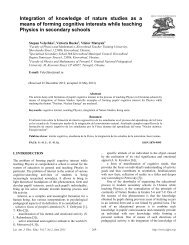
![Diversas formas de visualizar estados en un sistema cuántico [PDF]](https://img.yumpu.com/51151303/1/190x245/diversas-formas-de-visualizar-estados-en-un-sistema-cuantico-pdf.jpg?quality=85)

![Precession and nutation visualized [PDF]](https://img.yumpu.com/50786044/1/190x245/precession-and-nutation-visualized-pdf.jpg?quality=85)
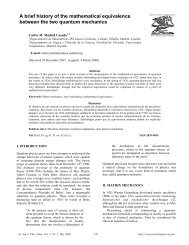
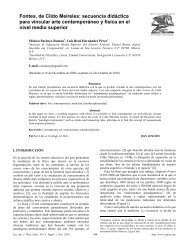
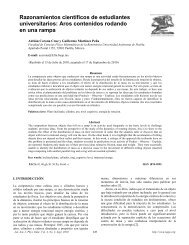

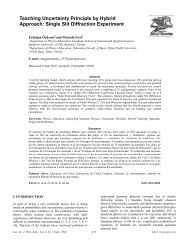
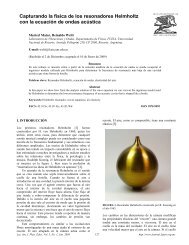
![Index [PDF] - Latin-American Journal of Physics Education](https://img.yumpu.com/47984121/1/190x245/index-pdf-latin-american-journal-of-physics-education.jpg?quality=85)
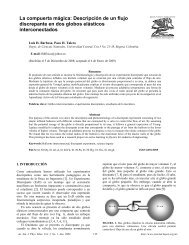
![Flujo de agua en botellas como experimento didáctico [PDF]](https://img.yumpu.com/43536300/1/190x245/flujo-de-agua-en-botellas-como-experimento-didactico-pdf.jpg?quality=85)
